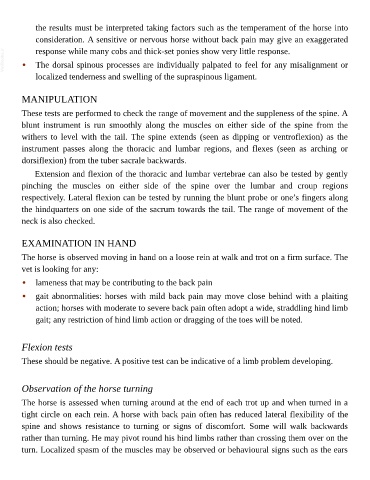Page 541 - The Veterinary Care of the Horse
P. 541
the results must be interpreted taking factors such as the temperament of the horse into
consideration. A sensitive or nervous horse without back pain may give an exaggerated
VetBooks.ir • response while many cobs and thick-set ponies show very little response.
The dorsal spinous processes are individually palpated to feel for any misalignment or
localized tenderness and swelling of the supraspinous ligament.
MANIPULATION
These tests are performed to check the range of movement and the suppleness of the spine. A
blunt instrument is run smoothly along the muscles on either side of the spine from the
withers to level with the tail. The spine extends (seen as dipping or ventroflexion) as the
instrument passes along the thoracic and lumbar regions, and flexes (seen as arching or
dorsiflexion) from the tuber sacrale backwards.
Extension and flexion of the thoracic and lumbar vertebrae can also be tested by gently
pinching the muscles on either side of the spine over the lumbar and croup regions
respectively. Lateral flexion can be tested by running the blunt probe or one’s fingers along
the hindquarters on one side of the sacrum towards the tail. The range of movement of the
neck is also checked.
EXAMINATION IN HAND
The horse is observed moving in hand on a loose rein at walk and trot on a firm surface. The
vet is looking for any:
• lameness that may be contributing to the back pain
• gait abnormalities: horses with mild back pain may move close behind with a plaiting
action; horses with moderate to severe back pain often adopt a wide, straddling hind limb
gait; any restriction of hind limb action or dragging of the toes will be noted.
Flexion tests
These should be negative. A positive test can be indicative of a limb problem developing.
Observation of the horse turning
The horse is assessed when turning around at the end of each trot up and when turned in a
tight circle on each rein. A horse with back pain often has reduced lateral flexibility of the
spine and shows resistance to turning or signs of discomfort. Some will walk backwards
rather than turning. He may pivot round his hind limbs rather than crossing them over on the
turn. Localized spasm of the muscles may be observed or behavioural signs such as the ears

